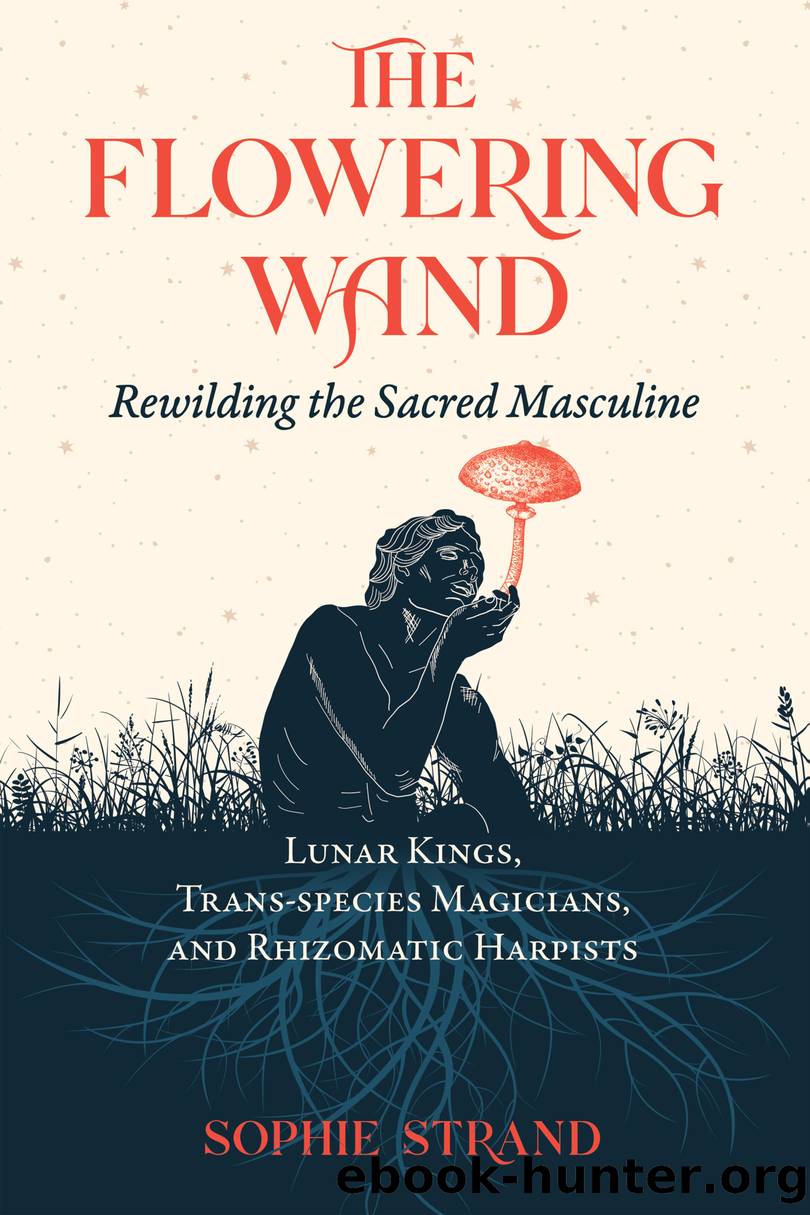The Flowering Wand by Sophie Strand

Author:Sophie Strand
Language: eng
Format: epub
Tags: Spirituality/Mythology
Publisher: Inner Traditions/Bear & Company
Published: 2022-10-04T00:00:00+00:00
The idea of the assemblage is just one narrative optionâand substituting one monomyth for another is not the answer to the poverty of narrative imagination facing the mythic masculine. We need to offer the masculine many different modes of narrative expression.
A holobiont is an assemblage of beings that creates a larger whole. The word was first used in 1991 by Lynn Margulis in an attempt to explain her study of hosts and inherited symbionts.5 With each passing day new research confirms that macroorganisms like us human beings are intimately tuned and shaped by the populations of microbes and fungi (or, as microbiologist Siv Watkins calls them, âsmallsâ) that populate our bodies. Our very cells were created by the fusion of ancient free-living prokaryotes. The closer we look at our bodies, the flimsier the idea of an individual, bounded self becomes. We are walking communities, swarms in suits and ties, skin-silhouetted Towers of Babel.
Perhaps, then, it is time to expand our idea of archetypes. Jungian archetypes are defined as ancient, universal ideas, modes of thought, or symbols that flower from the collective unconscious. These archetypes inhabit our myths and folklore. And the belief is that, over the course of our lives, we tend to embody different archetypes. Unfortunately, as happens with most attempts at mythical taxonomy, the idea of the archetype has become a sort of prison. We are the mother, the maid, or the crone. The anima or the shadow. Always an individual, always firmly within a codified state. The masculine, in particular, has been impoverished by the rigidity of certain archetypal approaches. What is the masculine allowed? King, warrior, magician, lover. I am, of course, referring to the popular book by Jungian analysts Robert Moore and Douglas Gillette, King, Warrior, Magician, Lover, wherein the authors argue that to be an integrated man, you must âmasterâ these archetypes.
Little surprise, then, that when confronted with such an impoverished selection, men are often easily shoved into the unspoken fifth and sixth options: the villain and the fool. But the masculine is not just four storybook characters. The masculine is numerous. And, most importantly, the masculine is not one star in the sky; it is a constellation of relationships, rather than a concrete singular. We are teeming cauldrons of aliveness. Holobionts. We need better ways of talking about archetypal expressions.
Let us offer the tarot as vital nourishment to the masculine. I donât want to throw out the king, the warrior, the magician, and the lover. I just want to add more archetypes to create a biodiversity of masculinities. A holobiont that can thrive, flexibly dance with change, and evolve. Like most mythologies, the tarot comes to us from beyond the horizon of âproof.â Some claim it began in Egypt. Others say it is a distinctly Kabbalistic practice. We know that the earliest tarot deck, distinct from other âplaying cards,â was designed by a mysterious man called Bonifacio Bembo in Milan in the mid-fifteenth century.
What I find particularly juicy about the tarot is that it is not one myth, it is many, and the modes of interpretation vary from reader to reader.
Download
This site does not store any files on its server. We only index and link to content provided by other sites. Please contact the content providers to delete copyright contents if any and email us, we'll remove relevant links or contents immediately.
Becoming Supernatural by Dr. Joe Dispenza(8064)
Crystal Healing for Women by Mariah K. Lyons(7838)
The Witchcraft of Salem Village by Shirley Jackson(7168)
Inner Engineering: A Yogi's Guide to Joy by Sadhguru(6661)
The Four Agreements by Don Miguel Ruiz(6566)
The Power of Now: A Guide to Spiritual Enlightenment by Eckhart Tolle(5567)
Secrets of Antigravity Propulsion: Tesla, UFOs, and Classified Aerospace Technology by Ph.D. Paul A. Laviolette(5268)
The Wisdom of Sundays by Oprah Winfrey(5063)
Room 212 by Kate Stewart(4989)
Pale Blue Dot by Carl Sagan(4880)
Fear by Osho(4638)
The David Icke Guide to the Global Conspiracy (and how to end it) by David Icke(4580)
Animal Frequency by Melissa Alvarez(4380)
Rising Strong by Brene Brown(4355)
How to Change Your Mind by Michael Pollan(4270)
Sigil Witchery by Laura Tempest Zakroff(4159)
Real Magic by Dean Radin PhD(4059)
Man and His Symbols by Carl Gustav Jung(4033)
The Art of Happiness by The Dalai Lama(4027)
